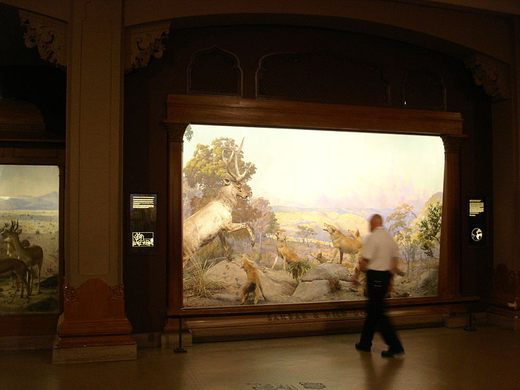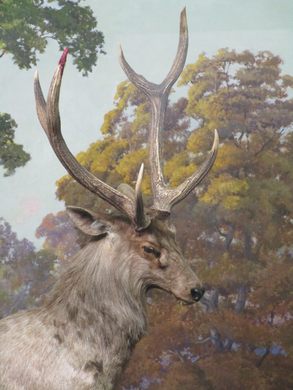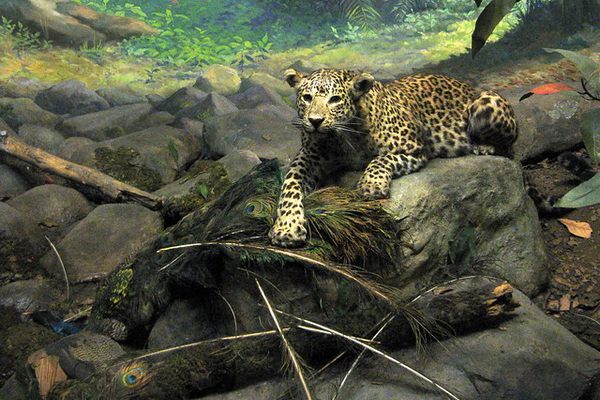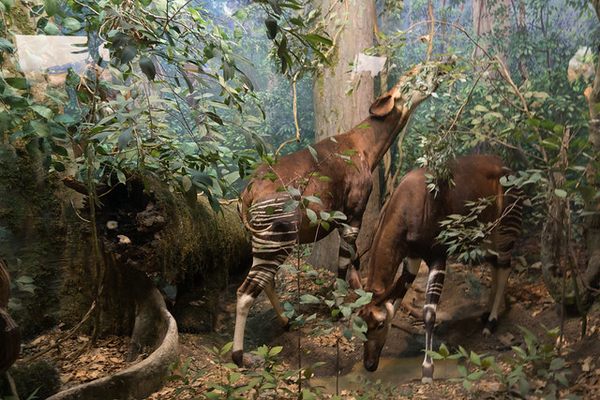AO Edited
Sambar and Wild Dog Diorama
This taxidermy scene brings the struggle for survival in the Indian jungle to a quiet corner of a Manhattan museum.
In this riveting taxidermy diorama at the American Museum of Natural History in New York, the sambar deer is portrayed caught in a moment of disquieting hesitation. One of the stag’s front legs is raised ready to stamp the ground with its hooves in a defensive display characteristic of all deer when threatened. Surrounding the terrified animal on all sides are a pack of baying wild dogs which snarl, snap, and bare their fangs, all the while pressing forward in a deadly flanking maneuver that has their prey seemingly cornered.
One of the dogs lies dead or close to death at the stag’s feet, felled by a savage kick of the deer’s hoof and trampled into the mud. But time and luck are running out for the sambar, which must choose either flight or fight. If it flees, it will either outrun its enemies or else succumb to their snapping fangs in a slow and gruesome death. Otherwise, it can take a stand and keep fighting, though it will inevitably tire or falter and be pulled down and torn to pieces by its tenacious enemies.
The Asiatic wild dog, or “dhole” as it is commonly known in India, is a formidable predator. Working intelligently in packs, it has been known to pursue and kill other apex predators such as leopards, and even on rare occasions, the Bengal tiger. Considering the wide geographic distribution that both species occupy, the scene depicted in this taxidermy diorama could take place anywhere, from the tropical dry forests of India and Nepal to the rainforests of Sumatra, Java, or Indochina. But the setting of this particular museum exhibit depicts the hill country of Mysore in southwestern India.
The power of this diorama lies in its ability to invoke a multiplicity of perspectives. For many viewers, the scene is a brutal drama in which they empathize anxiously with the desperate plight of the deer. Other visitors may appreciate this exhibit as a recreation of a timeless scene of predation, the wild dogs performing their ecological role of controlling a prey species that would otherwise overbrowse the forests. But there are many ways to interpret the narrative here, including within the context of the environmental history of India at the time the diorama was created.
For the British colonial administration of India and the Indian elite, who viewed the dhole as little more than vermin (and organized the culling of the species), such a scene would undoubtedly provoke irritation at the “destruction” of a game animal valued for recreational hunting. Conversely, for many of the indigenous forest tribes of the region, the sight or sound of a sambar being pursued by a pack of wild dogs would instead herald a meal of venison, as the dogs would be chased from their kills, which would be taken for village feasts.
But in the 21st century, this drama is imbued with an added poignancy, due to the awareness that such timeless scenes of the natural world may, in the near future, only be glimpsed through the medium of museum dioramas. Today, the dhole and its sambar deer prey are fast-disappearing from wide areas of the Indian subcontinent, where both species are listed as endangered. Indeed, the wild dog is considered by many conservationists to be at a far greater risk of extinction than its eternal enemy the Bengal tiger in many of India’s national parks.
Know Before You Go
The American Museum of Natural History (AMNH) is open from 10 a.m. to 5:45 p.m. every day. Entrance is free, but it is strongly recommended to contribute a small donation to the museum to help with its upkeep and outstanding scientific work. The sambar and wild dog diorama can be found in the excellent Hall of Asian Mammals, where there are many other incredible dioramas to see.
















Follow us on Twitter to get the latest on the world's hidden wonders.
Like us on Facebook to get the latest on the world's hidden wonders.
Follow us on Twitter Like us on Facebook